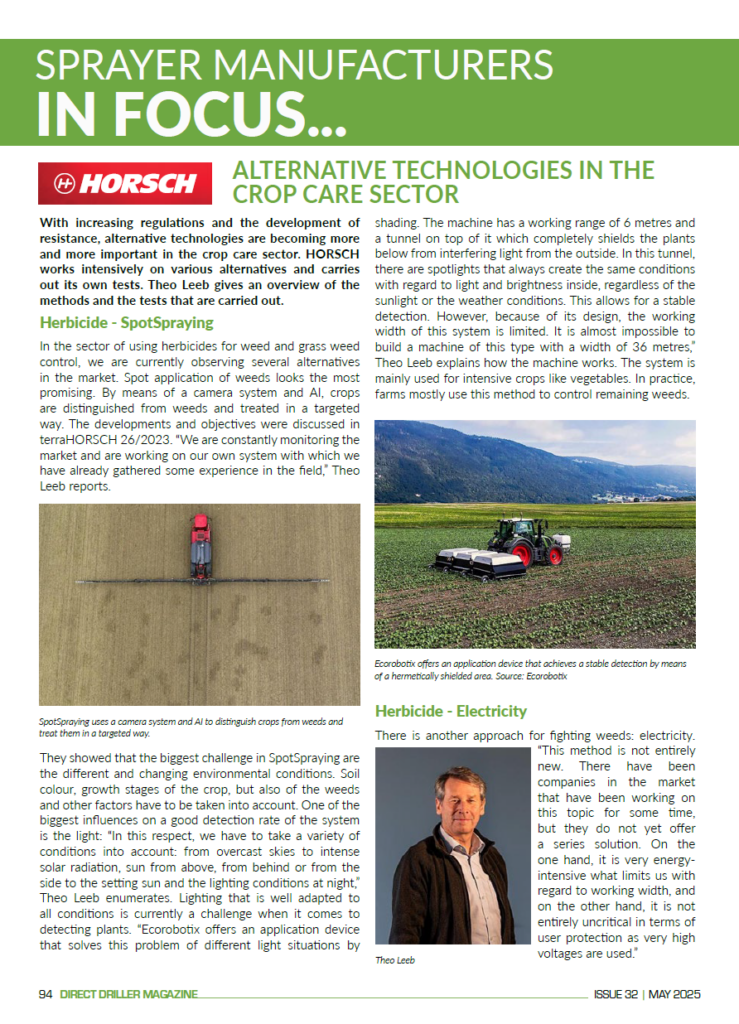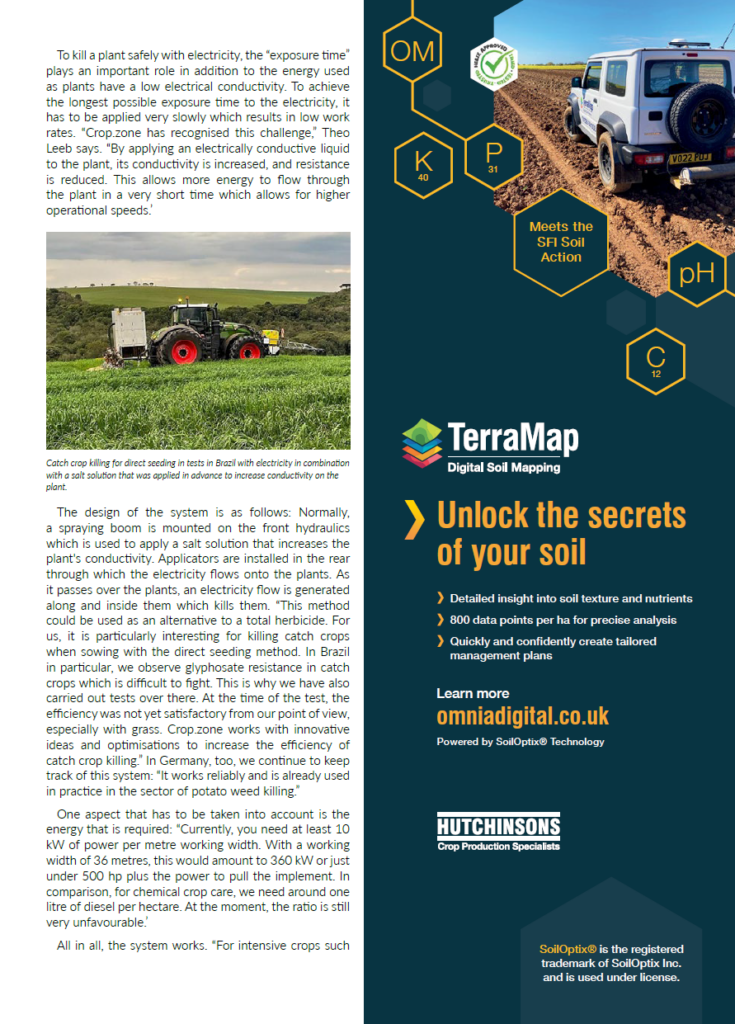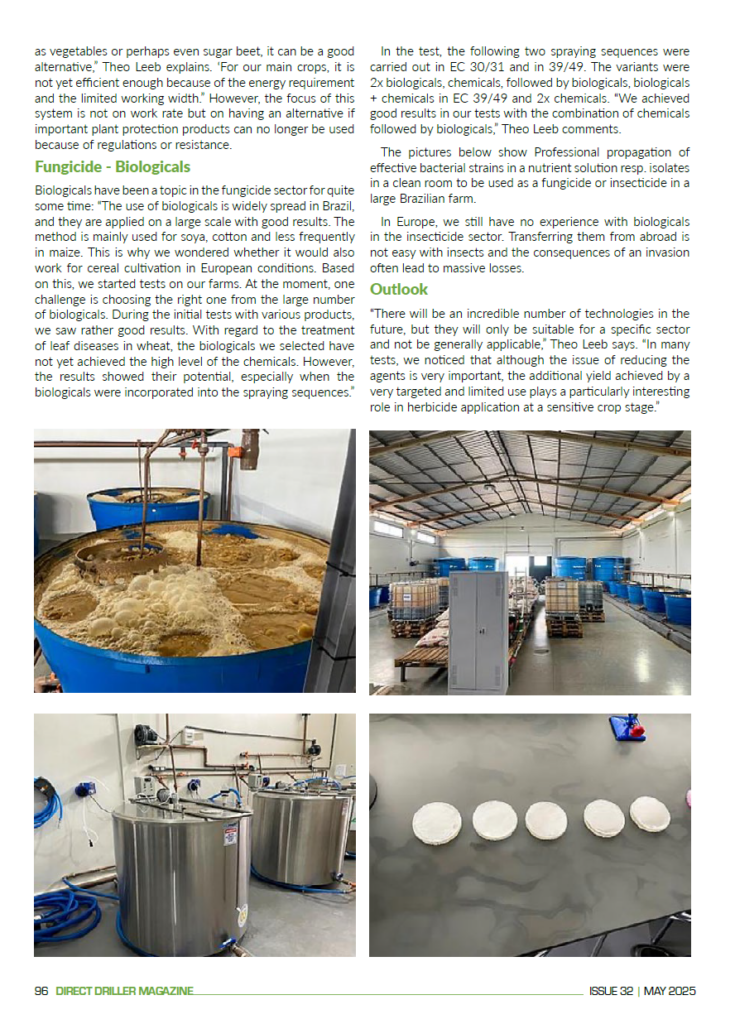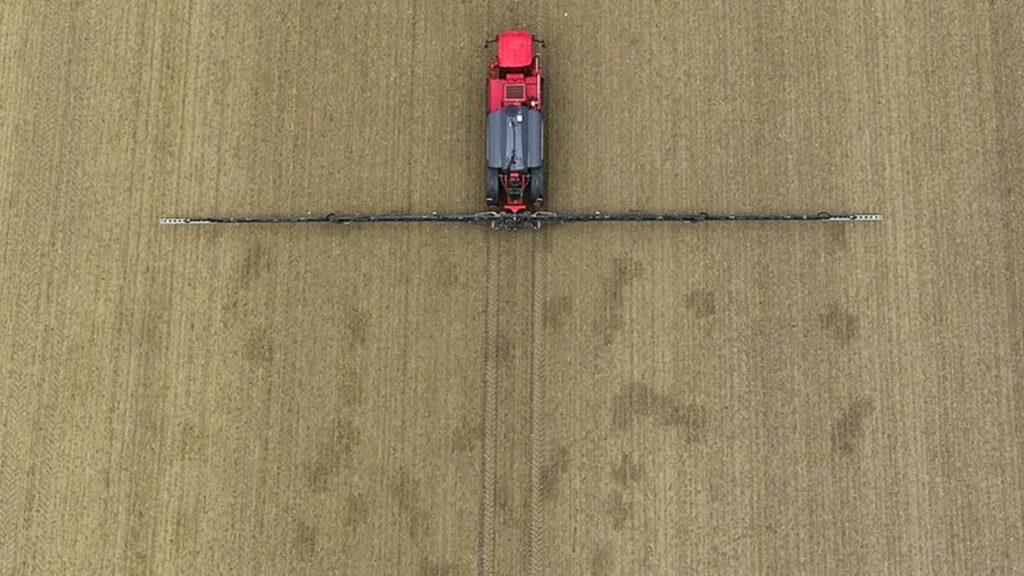With increasing regulations and the development of resistance, alternative technologies are becoming more and more important in the crop care sector. HORSCH works intensively on various alternatives and carries out its own tests. Theo Leeb gives an overview of the methods and the tests that are carried out.

Herbicide – SpotSpraying
In the sector of using herbicides for weed and grass weed control, we are currently observing several alternatives in the market. Spot application of weeds looks the most promising. By means of a camera system and AI, crops are distinguished from weeds and treated in a targeted way. The developments and objectives were discussed in terraHORSCH 26/2023. “We are constantly monitoring the market and are working on our own system with which we have already gathered some experience in the field,” Theo Leeb reports.
SpotSpraying uses a camera system and AI to distinguish crops from weeds and treat them in a targeted way.
They showed that the biggest challenge in SpotSpraying are the different and changing environmental conditions. Soil colour, growth stages of the crop, but also of the weeds and other factors have to be taken into account. One of the biggest influences on a good detection rate of the system is the light: “In this respect, we have to take a variety of conditions into account: from overcast skies to intense solar radiation, sun from above, from behind or from the side to the setting sun and the lighting conditions at night,” Theo Leeb enumerates. Lighting that is well adapted to all conditions is currently a challenge when it comes to detecting plants. “Ecorobotix offers an application device that solves this problem of different light situations by shading. The machine has a working range of 6 metres and a tunnel on top of it which completely shields the plants below from interfering light from the outside. In this tunnel, there are spotlights that always create the same conditions with regard to light and brightness inside, regardless of the sunlight or the weather conditions. This allows for a stable detection. However, because of its design, the working width of this system is limited. It is almost impossible to build a machine of this type with a width of 36 metres,” Theo Leeb explains how the machine works. The system is mainly used for intensive crops like vegetables. In practice, farms mostly use this method to control remaining weeds.
Ecorobotix offers an application device that achieves a stable detection by means of a hermetically shielded area. Source: Ecorobotix
Herbicide – Electricity
There is another approach for fighting weeds: electricity. “This method is not entirely new. There have been companies in the market that have been working on this topic for some time, but they do not yet offer a series solution. On the one hand, it is very energy-intensive what limits us with regard to working width, and on the other hand, it is not entirely uncritical in terms of user protection as very high voltages are used.”
Theo Leeb
To kill a plant safely with electricity, the “exposure time” plays an important role in addition to the energy used as plants have a low electrical conductivity. To achieve the longest possible exposure time to the electricity, it has to be applied very slowly which results in low work rates. “Crop.zone has recognised this challenge,” Theo Leeb says. “By applying an electrically conductive liquid to the plant, its conductivity is increased, and resistance is reduced. This allows more energy to flow through the plant in a very short time which allows for higher operational speeds.’
The design of the system is as follows: Normally, a spraying boom is mounted on the front hydraulics which is used to apply a salt solution that increases the plant’s conductivity. Applicators are installed in the rear through which the electricity flows onto the plants. As it passes over the plants, an electricity flow is generated along and inside them which kills them. “This method could be used as an alternative to a total herbicide. For us, it is particularly interesting for killing catch crops when sowing with the direct seeding method. In Brazil in particular, we observe glyphosate resistance in catch crops which is difficult to fight. This is why we have also carried out tests over there. At the time of the test, the efficiency was not yet satisfactory from our point of view, especially with grass. Crop.zone works with innovative ideas and optimisations to increase the efficiency of catch crop killing.” In Germany, too, we continue to keep track of this system: “It works reliably and is already used in practice in the sector of potato weed killing.”
Catch crop killing for direct seeding in tests in Brazil with electricity in combination with a salt solution that was applied in advance to increase conductivity on the plant.
One aspect that has to be taken into account is the energy that is required: “Currently, you need at least 10 kW of power per metre working width. With a working width of 36 metres, this would amount to 360 kW or just under 500 hp plus the power to pull the implement. In comparison, for chemical crop care, we need around one litre of diesel per hectare. At the moment, the ratio is still very unfavourable.’
All in all, the system works. “For intensive crops such as vegetables or perhaps even sugar beet, it can be a good alternative,” Theo Leeb explains. ‘For our main crops, it is not yet efficient enough because of the energy requirement and the limited working width.” However, the focus of this system is not on work rate but on having an alternative if important plant protection products can no longer be used because of regulations or resistance.
Fungicide – Biologicals
Biologicals have been a topic in the fungicide sector for quite some time: “The use of biologicals is widely spread in Brazil, and they are applied on a large scale with good results. The method is mainly used for soya, cotton and less frequently in maize. This is why we wondered whether it would also work for cereal cultivation in European conditions. Based on this, we started tests on our farms. At the moment, one challenge is choosing the right one from the large number of biologicals. During the initial tests with various products, we saw rather good results. With regard to the treatment of leaf diseases in wheat, the biologicals we selected have not yet achieved the high level of the chemicals. However, the results showed their potential, especially when the biologicals were incorporated into the spraying sequences.”
In the test, the following two spraying sequences were carried out in EC 30/31 and in 39/49. The variants were 2x biologicals, chemicals, followed by biologicals, biologicals + chemicals in EC 39/49 and 2x chemicals. “We achieved good results in our tests with the combination of chemicals followed by biologicals,” Theo Leeb comments.
Professional propagation of effective bacterial strains in a nutrient solution resp. isolates in a clean room to be used as a fungicide or insecticide in a large Brazilian farm.
Professional propagation of effective bacterial strains in a nutrient solution resp. isolates in a clean room to be used as a fungicide or insecticide in a large Brazilian farm.
Professional propagation of effective bacterial strains in a nutrient solution resp. isolates in a clean room to be used as a fungicide or insecticide in a large Brazilian farm.
Professional propagation of effective bacterial strains in a nutrient solution resp. isolates in a clean room to be used as a fungicide or insecticide in a large Brazilian farm.
Professional propagation of effective bacterial strains in a nutrient solution resp. isolates in a clean room to be used as a fungicide or insecticide in a large Brazilian farm.
Professional propagation of effective bacterial strains in a nutrient solution resp. isolates in a clean room to be used as a fungicide or insecticide in a large Brazilian farm.
Professional propagation of effective bacterial strains in a nutrient solution resp. isolates in a clean room to be used as a fungicide or insecticide in a large Brazilian farm.
Professional propagation of effective bacterial strains in a nutrient solution resp. isolates in a clean room to be used as a fungicide or insecticide in a large Brazilian farm.
In Europe, we still have no experience with biologicals in the insecticide sector. Transferring them from abroad is not easy with insects and the consequences of an invasion often lead to massive losses.
Outlook
“There will be an incredible number of technologies in the future, but they will only be suitable for a specific sector and not be generally applicable,” Theo Leeb says. “In many tests, we noticed that although the issue of reducing the agents is very important, the additional yield achieved by a very targeted and limited use plays a particularly interesting role in herbicide application at a sensitive crop stage.”



